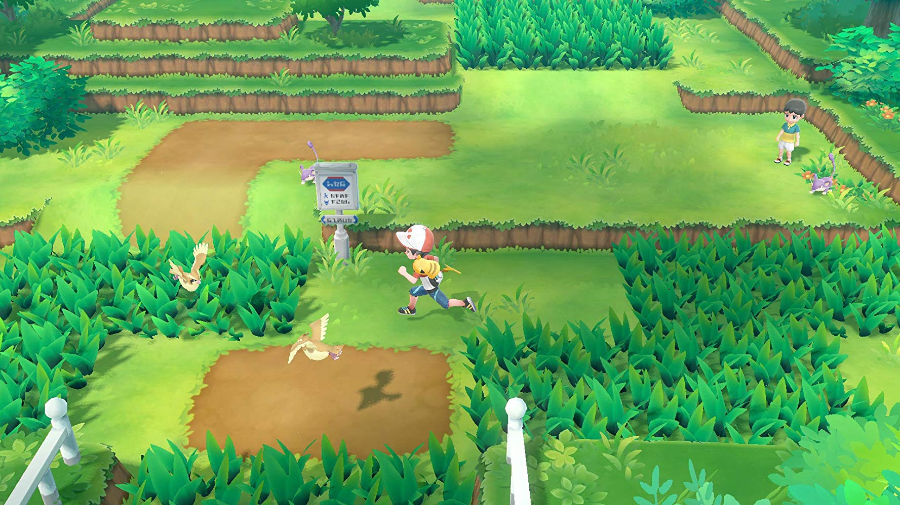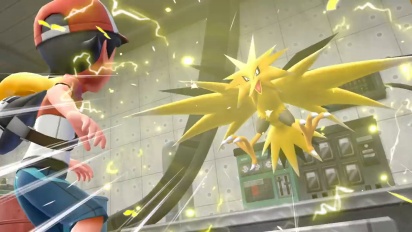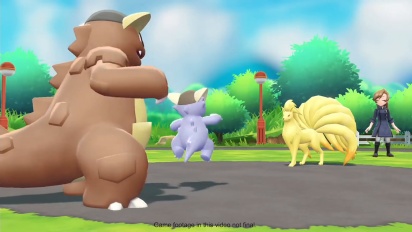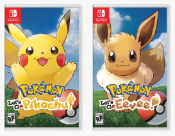Is there any connectivity between this and Pokemon GO? I thought I read there would be, but if there is, I haven't figured it out yet.
Pokemon Let's Go Eevee/Pikachu Review
|
|
See PixlBit's Review Policies

On 11/28/2018 at 09:00 AM by Casey Curran Spin-off? Remake? Soft reboot? |

Pokemon fans who play solely for the PvP battling mechanics will likely come away disappointed. Other fans and newcomers alike should be able to have a good time, just stick with handheld mode if you dislike motion controls.
After playing Pokemon Let’s Go Pikachu, I am convinced that Game Freak is incapable of dropping the ball (pun not intended). Everything about the new title convinced me that something had to go wrong. It’s a remake of Pokemon Yellow, a rehash of Red and Blue Versions (which already received remakes fourteen years ago). In addition, it’s incorporating the more shallow catching mechanics from the free to play Pokemon Go on mobile, usually the kiss of death a console game. On top of that, Nintendo has admitted it is a cash grab, as they wanted a Pokemon game on the Switch without rushing the true sequel. And yet, not only is Pokemon Let’s Go just as fun and addicting as the core titles, but I now I want Let’s Go sequels for every other Pokemon generation.
To get the elephant in the room out of the way: Yes, the new catching mechanic is both fun and addicting. I was very skeptical when I first saw that catching would be based on merely throwing a Pokeball, yet it brings its own advantages. Random battles are gone in favor of Pokemon roaming around the area, allowing the player to decide which creatures to capture and which to avoid. This works hand in hand with the combo system, where catching the same Pokemon multiple times in a row will offer more party experience and increase the likelihood of encountering a stronger Pokemon. Three different Pokeballs along with berries which increase the likelihood of capture add a bit of strategy to the mix, though I would have liked other Pokemon games’ greater variety of Pokeballs and berries to add more depth.
Yet the biggest point in Let’s Go’s catching is how fast and fluid everything feels. While capturing Pokemon would take at least a minute in the past, now they can be done as quick as fifteen seconds. This complements the new combo system well, as getting a combo is seamless enough to never feel tedious, even when hitting a thirty combo (when captures yield the highest rewards). These combos also increase the likelihood of rare Pokemon popping up, even Pokemon such as Charizard or Dragonite who were off limits in the past. The greater diversity in rare Pokemon lets the world feel more alive and exciting, and Kanto has never been more fun to explore.
This being a Nintendo game, however, there are a few odd design choices in regards to Let’s Go’s control options. These only apply to TV mode, as handheld mode allows you you to throw Pokeballs with a press of a button, and aiming done via the analog sticks and optional gyro controls. On a TV, however, the game only allows one Joycon per player and forces throwing the Pokemon to capture them.
For right handed gamers, this means moving will be done with the right analog stick below the face buttons, which is a rather odd choice not every player will have an easy time adapting to. The forced motion controls offer a greater hurdle, as not every gamer will be able to grasp them nor want to. The motion controls work with a few hiccups, yet handheld mode was my preferred method for rare and legendary Pokemon because of its greater reliability. It’s another annoyingly bizarre case of Nintendo restricting how you play their games.
While capturing Pokemon is a strong departure, battling remains tried and true for long time fans. There are some tweaks such as being able to swap Pokemon in and out of your party any time outside of battle and your entire party gaining experience (with no way to shut off the feature), but Let’s Go still consists of forming a team of 6 Pokemon of your choice each with four moves. It’s still fun, addicting, and surprisingly challenging, as trainers are plentiful and a single one can easily reduce one of your Pokemon to low health. On the other hand, gym leaders and bosses are easier than ever as your Pokemon will be in top health and able to topple them without too much effort.
Yet there are two additions to the Pokemon formula which Game Freak opted not to add for some strange reason: Hold items and abilities. These were introduced in 2000’s Gold/Silver and 2003’s Ruby/Sapphire respectively and remained in 2004’s remakes of the original so they’re quite bizarre omissions, as they added quite a bit of depth to the game. Hold items were given to Pokemon to grant a variety of perks, from a power boost, to mitigating a weakness, which vastly increased the customization options present in the game.
Abilities also added an extra layer of depth as they helped some previously generic Pokemon stand out more and acquire a unique niche. Seaking, for instance, was originally outclassed by most other water types without anything to stand out. Its ability Lightning Rod, however, gave it an immunity to Electric type attacks, turning one of its weaknesses into a strength and finding it new life. Not every Pokemon’s ability was this valuable, yet most added an extra layer of depth and it’s odd to see them removed.
Remaking the first generation of Pokemon also brings a lack of diversity among typings that there was no real way around. Dark and Steel types were nonexistent, with only Magnemite and its evolution retroactively adding a Steel type later. These types were created to balance the overpowered Psychic types, which run rampant once again. It is nowhere near as bad as before, as strong Bug, Dark, and Ghost moves are very common, but finding a Pokemon to tank their moves is an issue. Some Pokemon do have alternate forms (known as their Alolan form), which can be traded for, yet this will only add one solid Steel type (Dugtrio) and Dark type (Muk) respectively, with Alola Muk restricted to Let’s Go Pikachu.
Yet despite these grievances, I was pleasantly surprised with my time spent playing Pokemon Let’s Go. I absolutely do not want the changes to replace the regular formula, yet I definitely want more Let’s Go games to complement the main series. Catching ‘em all has never been a priority ever since the series surpassed six hundred Pokemon, but Let’s Go revitalizes the mechanic to the point where I could see myself getting all eight hundred nine current Pokemon with the formula. And that’s the sign of a great ... spin-off? Remake? Soft reboot? Whatever it is, it’s a success.
The greatest difference between Let’s Go Pikachu Edition or Let’s Go Eevee Edition is fittingly whether you start the game with a Pikachu or Eevee. This will likely be the biggest factor for which version you choose, as both are fun and adorable companions throughout your journey. Neither will disappoint, as each is far stronger than your average Pikachu and Eevee. Pikachu is faster and hits harder, while Eevee can take more hits and has a more diverse (and borderline broken) movepool. You can still catch a Pikachu or Eevee in the wild for both versions, but they won’t be half as fun or charming as your starter.
While the option to pick a Pikachu or Eevee is mostly a matter of personal taste, Let’s Go Pikachu unquestionably offers the better assortment of exclusive wild Pokemon. There is a greater variety between types of Pokemon, exclusive Pokemon are generally stronger, and Alolan Muk stands out as the one solid Dark type Pokemon. As Dark types offer an immunity to Psychic moves, Alolan Muk is essential for players who struggle against Psychic types. While I would recommend Pikachu over Eevee for players on the fence, those who prefer Eevee or any of its version exclusives will still be satisfied.













Side By Side - Pikachu vs. Eevee